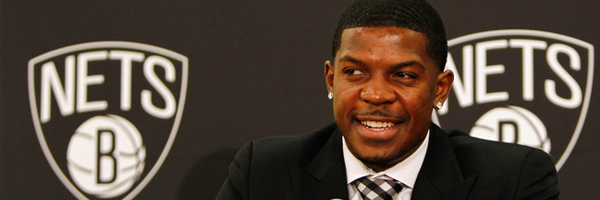Some people seem to have Joe Johnson all wrong.
Brooklyn’s 6-time all-star shooting guard has acquired a certain reputation as a result of his years in Atlanta. Under Mike Woodson’s system, Johnson was thrust into national spotlight as the headpiece of a classic one-man offense.
His numbers did not disappoint: In his second year as a Hawk, Johnson went for 25 ppg, 4.4 apg, 4.2 rpg on 46% from the field and 38% from three-point range.
As an unintended side effect, Johnson also became something of a black hole on offense. Though shooting a relatively decent percentage-his lowest as a Hawk being 43% back in the 2007-2008 season-Johnson put up a number in a particular category that was alarming.
Usage rate, or USG, is the percentage of plays used by a player while on the floor (as defined by basketball-reference.com). Johnson took up 28% of the Hawks’ offense in the ’06-’07 campaign. Just to get an idea of how high that is, Kobe Bryant was responsible for 33% of the Lakers’ offense in the same season.
That figure does little justice for a player who often comes across as subdued, if not altogether detached. Make no mistake, he competes when he’s out there, rarely caught languishing on one end of the court. But, Johnson’s demeanor nonetheless evokes not the picture of a ‘ball-hog’ or ‘black hole’, but that of a star following his coach.
“I don’t know where the Iso-Joe comes from,” said Joe Johnson, sounding more bemused than annoyed.
–Via NY Times.
And why would he? Johnson has never shown an aversion towards one-man basketball. He was a player who fell under the porous umbrella of a flawed offense. Though Johnson relished the opportunity to be an offensive spearhead, he never begged for it. Those ‘iso-joe’ moments were actual plays from a NBA coach’s playbook, believe it or not.
Most often, you’ll hear criticism towards Johnson pointing specifically towards the canyon gap between his talent level and contract. The Nets took on a $90 million commitment when they traded for Johnson. There’s very little actual criticisms to be made here in the way of Johnson as a player.
Did the Hawks screw up in offering a sultan’s ransom? Sure, they did. But Johnson opting to feed his family for generations rather than asking for a lower sum has nothing to do with his value as a player in this league.
And then there are the questions concerning Johnson’s “need” for the ball. Specifically, his years at Atlanta have left some feeling as though Johnson needs to dominate possession to be effective.
In his last year with the Phoenix Suns, he played third and even fourth fiddle to a cast that included Amare Stoudemire and Steve Nash.
Even with Johnson representing another cog in the frantic Suns offense, he found ways to be productive. Because Phoenix had been an up-tempo, “7-seconds or less” offense, Johnson managed to pick his spots and ended his last year in the valley of the sun with 17.1 ppg, 5.1 rpg, and 3.3 apg.
Johnson is a talented shooting guard with the size, vision, and shooting touch to be effective on just about any team. That he was charged with the lion’s share of ATL’s offense in an iso-heavy system means very little substantially.
If anything, Johnson’s acceptance of that role as the Hawks’ offensive leader, despite his seemingly contradictory nature, is a sign of coachability.
Here’s something else to consider with Johnson: it’s been a while since he’s had an elite back-court-mate. The last time Johnson had a in-his-prime PG by his side was when he was a Sun in 2004-2005, and Steve Nash was the NBA’s MVP.
That year, Johnson shot 48% from three-point territory, good for 2nd in the league.
Mohamed Abdihakim is a journalism student at Florida Atlantic University. He is a Phoenix Suns fan, who is not prepared for the possibility of Nash winning a title in a Lakers jersey. Mohamed is also a contributor at “Les Snobs”. Interests include International basketball, Mad Men, and blues music. Nearly all stats are credited to Hoopdata or Basketball-Reference.
Twitter handle: @Abdi_hakim



















